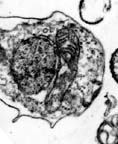Salpingoeca
Index
|
Introduction
|
Appearance
|
Ultrastructure
|
Reproduction and Life History
|
Similar genera
|
Classification
|
Taxonomy and Nomenclature
|
Cultures
|
References
|
Internet resources
ULTRASTRUCTURE
 Salpingoeca cells are
uninucleate (have one nucleus) and have one or more mitochondria,
dispersed throughout the cell.
The theca is visible as a thin vaselike structure surrounding the cell,
often closely appressed to the cell surface. At the
anterior end of the cell, a pair of basal bodies appears, only
one of which is associated with an emergent flagellum. An
electron-dense peripheral ring surrounds the flagellum-bearing
basal body. Beneath the basal body complex, a single Golgi
body occurs. Tentacles arise from various regions around the
cell and extend apically to form the collar. Food particles
are attached to the tentacles and transported to the cell body,
where they are digested in food vacuoles
Salpingoeca cells are
uninucleate (have one nucleus) and have one or more mitochondria,
dispersed throughout the cell.
The theca is visible as a thin vaselike structure surrounding the cell,
often closely appressed to the cell surface. At the
anterior end of the cell, a pair of basal bodies appears, only
one of which is associated with an emergent flagellum. An
electron-dense peripheral ring surrounds the flagellum-bearing
basal body. Beneath the basal body complex, a single Golgi
body occurs. Tentacles arise from various regions around the
cell and extend apically to form the collar. Food particles
are attached to the tentacles and transported to the cell body,
where they are digested in food vacuoles
|
 The mitochondrial cristae are
flattened.
The mitochondrial cristae are
flattened.
|
 As in other
choanoflagellates such as Monosiga, the cytoskeleton is
based
on a symmetrical system of radially arranged microtubules surrounding
a single flagellar base. As in other
choanoflagellates such as Monosiga, the cytoskeleton is
based
on a symmetrical system of radially arranged microtubules surrounding
a single flagellar base.
|
Salpingoeca: Index
|
Introduction
|
Appearance
|
Ultrastructure
|
Reproduction and Life History
|
Similar genera
|
Classification
|
Taxonomy and Nomenclature
|
Cultures
|
References
|
Internet resources
Protist Image
Data: Picture Gallery
|
Home Page
|
 The mitochondrial cristae are
flattened.
The mitochondrial cristae are
flattened.
 As in other
choanoflagellates such as Monosiga, the cytoskeleton is
based
on a symmetrical system of radially arranged microtubules surrounding
a single flagellar base.
As in other
choanoflagellates such as Monosiga, the cytoskeleton is
based
on a symmetrical system of radially arranged microtubules surrounding
a single flagellar base.
